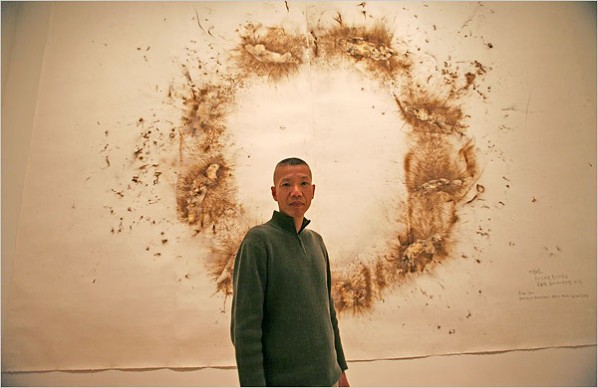
Computer rendering of the new installation work ”Homecoming” at Mathaf: Arab Museum of Modern Art. View of installation in the Museum’s courtyard. Proposed medium: 60 carved rocks. Dimensions variable, Courtesy Cai Studio
“Qatar Museums Authority is pleased to advance our mission to encourage global cultural dialogue and exchange by presenting the work of Cai Guo-Qiang at Mathaf,” said Qatar Museums Authority Chairperson Her Excellency Sheikha Al Mayassa bint Hamad bin Khalifa Al-Thani. “Through this exhibition, Cai Guo-Qiang will use his perspective as an artist to further extend the relationship between China and Arabia that dates back to the Silk Road, all the while exploring the possibility of direct dialogue between two cultures in the new context of globalization.”
In Saraab (“mirage” in Arabic), Cai will explore the complex connections between Qatar and Cai’s hometown of Quanzhou, a city once known as one of China’s largest seaports and a gateway to the historic Silk Road on sea. Saraab will showcase Cai’s body of work and approach, crossing artistic mediums of drawing, installation, video, and his celebrated explosion events. 16 new pieces will be created for the show, including large-scale, site-specific installations and new examples of his signature “gunpowder drawings.” The creative process of the latter, produced with the assistance of local volunteers, will be open to the public. The new works will be influenced or inspired by Islamic architectural forms and decorative patterns that depict such diverse motifs as the desert landscape, navigation, ceramics, calligraphy, and animals. In addition, Saraab will include thirty recent works and nine documentary videos that trace the artist’s development over the years as well as expand awareness of the artist’s creative process.
“With this exhibition, Mathaf will offer a unique take on the Arab world of yesterday and today, presenting a show with a strong relationship to place—one that is truly of and inspired by Doha,” said Mathaf director Wassan Al-Khudhairi. “Cai Guo-Qiang: Saraab also continues Mathaf’s commitment to being an incubator of ideas by encouraging new work by non-Western artists and documenting the artistic method.”
“The exhibition at Mathaf gives me an opportunity to read and understand what is written in Arabic on the tombstones and steles that were everywhere in my hometown growing up,” said the artist. “A creative journey begins with these inscriptions, and the whole project is an attempt to connect the history and culture of my hometown with Arab history and with the culture of Qatar. From this, associations of how Arab culture at present relates to the rest of the world are formed. For many of the new works, their materials and forms were inspired by Arab culture. To foster an exchange and to collaborate with the local community is also an important aspect in the creation of these works.”
Source: Report above is quoted from "Cai Guo-Qiang to Open First Show in the Middle East at Mathaf: Arab Museum of Modern Art" on artdaily.org.

Cai Guo Qiang in front of his work I Want to Believe Courtesy Cai Studio
Cai Guo-Qiang was born in 1957 in Quanzhou City, Fujian Province, China. Trained in stage design at the Shanghai Theater Academy, his work has since crossed multiple mediums within art, including drawing, installation, video and performance art. While living in Japan from 1986 to 1995, he explored the properties of gunpowder in his drawings, an inquiry that eventually led to his experimentation with explosives on a massive scale and to the development of his signature explosion events. Drawing upon Eastern philosophy and contemporary social issues as a conceptual basis, these projects and events aim to establish an exchange between viewers and the larger universe around them, utilizing a site-specific approach to culture and history. He currently lives and works in New York.
Cai was awarded the Japan Cultural Design Prize in 1995 and the Golden Lion at the 48th Venice Biennale in 1999. In the following years, he has received the International Association of Art Critics (AICA), New England for Best Installation or Single Work in a Museum (2005), the 7th Hiroshima Art Prize (2007), the 20th Fukuoka Asian Culture Prize (2009), and AICA抯 first place for Best Project in a Public Space for Cai Guo-Qiang: Fallen Blossoms (2010).
Among his many solo exhibitions and projects include Cai Guo-Qiang on the Roof: Transparent Monument, Metropolitan Museum of Art, New York, 2006; Transient Rainbow, Museum of Modern Art, New York, 2002, and APEC Cityscape Fireworks Show, Asia Pacific Economic Cooperation, Shanghai, 2001. He also curated the first China Pavilion at the 51st Venice Biennale, 2005, and held the distinguished position as Director of Visual and Special Effects for the opening and closing ceremonies of the 2008 Summer Olympics in Beijing.
More recently, Cai's retrospective I Want to Believe opened at the Solomon R. Guggenheim Museum, New York in February 2008 before traveling to the National Art Museum of China in Beijing in August 2008 and then to the Guggenheim Bilbao in March 2009. Last year Cai Guo-Qiang: Peasant Da Vincis, opened in May 2010 as the inaugural exhibition of the Rockbund Art Museum in Shanghai. Cai also created Odyssey, a permanent gunpowder drawing for the Museum of Fine Arts, Houston in Fall 2010. Installed as part of the museum's ongoing Portals Project, it is one of his largest gunpowder drawings to date. Another solo exhibition Cai Guo-Qiang: Sunshine and Solitude was recently on view at Museo Universitario Arte Contemporaeo, Mexico City.
In December 2011, Cai will have a solo exhibition Cai Guo-Qiang Mirage at the Mathaf: Arab Museum of Modern Art in Doha, Qatar, his first ever in a Middle Eastern country. Cai will also be featured in a solo show at Museum of Contemporary Art, Los Angeles in 2012.
Courtesy Cai Studio




























